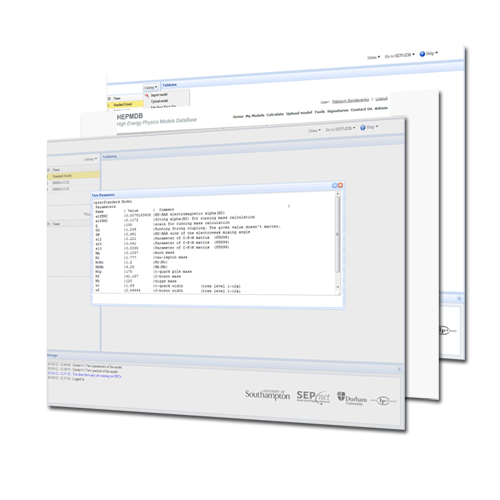HEPMDB
What is HEPMDB?The High Energy Physics Model Database (HEPMDB) was created to facilitate the connection between high energy physics theory and experiment, to store and validate theoretical models, and to develop a dictionary of the model signatures which identifies the fundamental theories responsible for signals expected at the LHC. HEPMDB is also designed to collect different signatures of its models and their respective experimental efficiencies. Using this information, HEPMDB will be able to compare its Beyond Standard Model (BSM) predictions with LHC data. In doing so, HEPMDB will be able to discriminate the underlying theory. The database is in the development stage and your input in the 'Forum' section is highly appreciated. The database collects particle physics models. These models are supposed to be public and represent themselves as a set of Feynman Rules which can be expressed in the input form of any matrix element generator such as CalcHEP, CompHEP, FeynArts, Madgraph, SHERPA, WHIZARD. HEPMDB has an entrance for Model authors -- 'Authors' -- where Authors can test and validate their models. To become an 'Author' you should register in the 'Register' section. 'Authors' are welcome to upload the LanHEP or FeynRules sources of their models. Further InformationPresently, this allows for the collection of high energy physics models, the ability to perform symbolic and numerical calculations of particle scattering processes and the storage of results for the respective model simulations. CalcHEPFor the evaluation of particle physics processes, HEPMDB uses CalcHEP software package and gives users an option to run simulations on a remote HPCx supercomputing cluster. CalcHEP software is designed for automatic calculation of Feynman diagrams for generic models of elementary particle interactions. CalcHEP allows researchers to predict various observables for new models which provides an opportunity to compare model predictions with a large number amount of experimental data from particle accelerators. The status of CalcHEP for world-leading theoretical and experimental High Energy Physics groups is well established (it has been used and respectively cited in about 300 journal publications since 2004). It has been effectively used by the HEP community. CalcHEP was created in 1999 from the CompHEP package which now counts more than 600 citations since 1999. In terms of the computing side of this software, there are several avenues of improving and exploiting the current capabilities. In comparison with analogous packages which will be mentioned below, CalcHEP has several features which make it one of the world-leading tools for exploring particle physics. One of these features is a convenient menu-driven Graphical User Interface (GUI) with the detailed context help. This detailed context help is designed so that a user can start using CalcHEP straight after its installation. Among other important features of CalcHEP is the option to easily implement a new model with an internal editor or external editors/packages. CalcHEP gives the user the option to perform calculations in two different gauges. This provides a powerful cross check of the model implementation and the batch interface. The batch interface allows the user to automate the input of many processes of production and decay, event generation and produce various kinematical distributions. One should also stress an additional feature of the batch interface which is to allow parallel calculations on multiprocessor clusters. This significantly enhances CalcHEP's performance. AlternativesOne should note that there are alternative programs to CalcHEP, which can also be used by HEPMDB. These include : MADGRAPH, WHIZARD and CompHEP.
Back to HEPMDB site |
